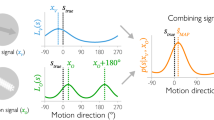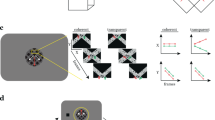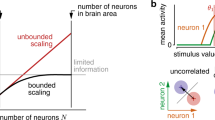Abstract
Perceptual illusions are usually thought to arise from the way sensory signals are encoded by the brain, and indeed are often used to infer the mechanisms of sensory encoding1. But perceptual illusions might also result from the way the brain decodes sensory information2, reflecting the strategies that optimize performance in particular tasks. In a fine discrimination task, the most accurate information comes from neurons tuned away from the discrimination boundary3,4, and observers seem to use signals from these ‘displaced’ neurons to optimize their performance5,6,7. We wondered whether using signals from these neurons might also bias perception. In a fine direction discrimination task using moving random-dot stimuli, we found that observers’ perception of the direction of motion is indeed biased away from the boundary. This misperception can be accurately described by a decoding model that preferentially weights signals from neurons whose responses best discriminate those directions. In a coarse discrimination task, to which a different decoding rule applies4, the same stimulus is not misperceived, suggesting that the illusion is a direct consequence of the decoding strategy that observers use to make fine perceptual judgments. The subjective experience of motion is therefore not mediated directly by the responses of sensory neurons, but is only developed after the responses of these neurons are decoded.
This is a preview of subscription content, access via your institution
Access options
Subscribe to this journal
Receive 51 print issues and online access
$199.00 per year
only $3.90 per issue
Buy this article
- Purchase on Springer Link
- Instant access to full article PDF
Prices may be subject to local taxes which are calculated during checkout




Similar content being viewed by others
References
Eagleman, D. M. Visual illusions and neurobiology. Nature Rev. Neurosci. 2, 920–926 (2001)
Gregory, R. L. Eye and Brain: The Psychology of Seeing 5th edn (Oxford Univ. Press, 1997)
Seung, H. S. & Sompolinsky, H. Simple models for reading neuronal population codes. Proc. Natl Acad. Sci. USA 90, 10749–10753 (1993)
Jazayeri, M. & Movshon, J. A. Optimal representation of sensory information by neural populations. Nature Neurosci. 9, 690–696 (2006)
Patterson, R. D. Auditory filter shapes derived with noise stimuli. J. Acoust. Soc. Am. 59, 640–654 (1976)
Regan, D. & Beverley, K. I. Postadaptation orientation discrimination. J. Opt. Soc. Am. A 2, 147–155 (1985)
Hol, K. & Treue, S. Different populations of neurons contribute to the detection and discrimination of visual motion. Vision Res. 41, 685–689 (2001)
Parker, A. J. & Newsome, W. T. Sense and the single neuron: probing the physiology of perception. Annu. Rev. Neurosci. 21, 227–277 (1998)
Dean, A. F. The variability of discharge of simple cells in the cat striate cortex. Exp. Brain Res. 44, 437–440 (1981)
Tolhurst, D. J., Movshon, J. A. & Dean, A. F. The statistical reliability of signals in single neurons in cat and monkey visual cortex. Vision Res. 23, 775–785 (1983)
Britten, K. H., Shadlen, M. N., Newsome, W. T. & Movshon, J. A. The analysis of visual motion: a comparison of neuronal and psychophysical performance. J. Neurosci. 12, 4745–4765 (1992)
Huttenlocher, J., Hedges, L. V. & Duncan, S. Categories and particulars: Prototype effects in estimating spatial location. Psychol. Rev. 98, 352–376 (1991)
Rauber, H. & Treue, S. Reference repulsion when judging the direction of visual motion. Perception 27, 393–402 (1998)
Acknowledgements
This work was supported by a research grant from the NIH. We are grateful to B. Lau, E. Simoncelli, D. Heeger, M. Landy and N. Graham for advice and discussion.
Author information
Authors and Affiliations
Corresponding author
Ethics declarations
Competing interests
Reprints and permissions information is available at www.nature.com/reprints. The authors declare no competing financial interests.
Supplementary information
Supplementary Information
This file contains Supplementary Methods, Supplementary Figures 1–3 with Legends and Supplementary Discussion. The Supplementary Information includes two Supplementary Figures detailing the fit of a more complete model to the data, a Supplementary Figure showing a breakdown of the data from Fig. 4, and a discussion of the possible role of response bias in the results reported. (PDF 622 kb)
Rights and permissions
About this article
Cite this article
Jazayeri, M., Movshon, J. A new perceptual illusion reveals mechanisms of sensory decoding. Nature 446, 912–915 (2007). https://doi.org/10.1038/nature05739
Received:
Accepted:
Published:
Issue Date:
DOI: https://doi.org/10.1038/nature05739
This article is cited by
-
Introspective inference counteracts perceptual distortion
Nature Communications (2023)
-
Evidence integration and decision confidence are modulated by stimulus consistency
Nature Human Behaviour (2022)
-
Neural structure of a sensory decoder for motor control
Nature Communications (2022)
-
Causal contribution of optic flow signal in Macaque extrastriate visual cortex for roll perception
Nature Communications (2022)
-
Effects of order on memory of event times
Scientific Reports (2021)
Comments
By submitting a comment you agree to abide by our Terms and Community Guidelines. If you find something abusive or that does not comply with our terms or guidelines please flag it as inappropriate.



